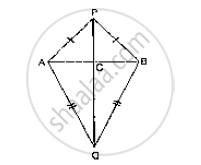Advertisements
Advertisements
प्रश्न
P is a point on the bisector of an angle ∠ABC. If the line through P parallel to AB meets BC at Q, prove that triangle BPQ is isosceles.
उत्तर
Given that P is a point on the bisector of an angle ABC, and PQ|| AB.
We have to prove that ΔBPQis isosceles
Since,
BP is bisector of ∠ABC⇒∠ABP=∠PBC ............(1)
Now,
PQllAB
⇒ ∠BPQ=∠ABP ................(2)
[alternative angles]
From (1) and (2), we get
∠BPQ=∠PBC(or)∠BPQ=∠PBQ
Now,
In , ΔBPQ
∠BPQ=∠PBQ
⇒ΔBPQ is an isosceles triangle.
∴Hence proved
APPEARS IN
संबंधित प्रश्न
In an isosceles triangle ABC, with AB = AC, the bisectors of ∠B and ∠C intersect each other at O. Join A to O. Show that:
- OB = OC
- AO bisects ∠A
AB is a line seg P and Q are points on opposite sides of AB such that each of them is equidistant from the points A and B (See Fig. 10.26). Show that the line PQ is perpendicular bisector of AB.

PQR is a triangle in which PQ = PR and S is any point on the side PQ. Through S, a line is drawn parallel to QR and intersecting PR at T. Prove that PS = PT.
Which of the following statements are true (T) and which are false (F):
Angles opposite to equal sides of a triangle are equal
In the given figure, the sides BC, CA and AB of a Δ ABC have been produced to D, E and F respectively. If ∠ACD = 105° and ∠EAF = 45°, find all the angles of the Δ ABC.
Write the sum of the angles of an obtuse triangle.
If the angles A, B and C of ΔABC satisfy the relation B − A = C − B, then find the measure of ∠B.
In a triangle ABC, if AB = AC and AB is produced to D such that BD = BC, find ∠ACD: ∠ADC.
D is a point on the side BC of a ∆ABC such that AD bisects ∠BAC. Then ______.
Show that in a quadrilateral ABCD, AB + BC + CD + DA < 2(BD + AC)
